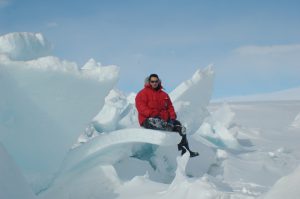
Assistant Professor
Office: Anatomy/Zoology Building E308
Phone: 970-491-0782
Email:
I am a Brooklyn, New York native transformed into the rare hybrid of a Texas Aggie who worked for the University of Texas System and is an Assistant Professor at Colorado State University.
I have often been asked how a kid from New York City became interested in marine biology and physiology. As a child, I remember watching the Undersea World of Jacques Cousteau and being fascinated by the ocean and its marine life. From there, my love of the marine world continued to grow as I read all of Cousteau’s books and anything else I could about the ocean. Since my days in grammar school, I wanted to be an Oceanographer/Marine Biologist. During my senior year at Xaverian High School, I had the opportunity to meet and discuss a career in marine biology with the Director of the New York Aquarium, Dr. George Ruggieri. Dr. Ruggieri encouraged me to pursue a degree in Marine Science at Southampton College of Long Island University.
In addition to an excellent academic program, Southampton offered an extensive internship and co-operative educational program, which played an essential role in sculpting my future career. As a sophomore, I undertook my first great adventure, when I spent a semester at sea crewing on a 110 ft schooner from Glouchester, Massachusetts north to Appledore, Maine and then down the Atlantic coast, ending in the Dominican Republic. While on seamester, my crewmates and I were required to take a full semester’s worth of courses, which included Marine ecology, Ichthyology, Literature and of course sailing. What made the trip so amazing, besides the dolphins, whales, and sharks we were seeing on a daily basis, was the fact that everything we were learning about in the classroom was only a field trip away. My semester at sea has provided memories and experiences that I still call upon some fifteen years later. During my college career, I became fascinated with how an animal’s body works while swimming underwater, or gliding through waves. What I came to learn was that I was fascinated with the physiology of animals. My interest in physiology was further solidified during my senior year when I became an intern for Dr. Gerry Kooyman in the Physiological Research Lab at Scripps Institute of Oceanography in San Diego, California. During that year, we studied the diving physiology and metabolism of California sea lions, harbor seals, thick-billed murres, and king and emperor penguins. At Scripps, I developed the basic ideas that would later develop into my Ph.D. topic and set the groundwork for our current project in Antarctica.
After my time at Scripps, I went on to receive my PhD. in exercise and skeletal muscle physiology from TexasA&MUniversity under the guidance of Dr. Randall W. Davis. During my Ph.D., I had the opportunity to participate in a host of different studies. In specific projects, I have studied diving behavior and physiology, fuel homeostasis, reproductive behavior and energetics, foraging behavior and energetics, thermoregulation, and swimming energetics in a variety of marine and terrestrial mammals. My research has not only been limited to physiology, but has spanned a number of biological and oceanographic disciplines investigating different ecological questions. In additional projects, I have studied reproductive and courting behavior, migratory patterns, deep-sea benthic environments and the distribution marine mammals in relation to oceanographic characteristics in the Gulf of Mexico. This diverse research experience enables me to provide a broad perspective to my current research dealing with physiological and ecological topics.
Upon completion of my dissertation, I returned to the University of California at San Diego as a National Institute of Health Minority Postdoctoral Research Associate in the Physiology section of the School of Medicine working with Dr. Peter Wagner and Dr. Odile Mathieu-Costello. My research dealt with biochemical and morphological adaptations of skeletal muscles to hypoxia in breath-hold diving and high altitude adapted mammals and birds. After San Diego, I joined the lab of Dr. R. Sanders Williams at the University of Texas Southwestern Medical Center in Dallas. While in Dallas I started to learn the molecular techniques that are now a core area of my current research. After our last expedition to the ice, I moved from Dallas to Fort Collins Colorado; where I joined the faculty of the Department of Biology at Colorado State University as an Assistant Professor.
While my basic ideas have matured beyond being the next Jacque Cousteau, I guess the answer to the question of how a kid from New York City becomes a marine biologist is, that he followed his heart and dared to dream big. The best advice I can give is to do whatever it takes to achieve your goal, and never let anyone or anything discourage you from achieving those dreams. Seek the advice and guidance of your parents, teachers and mentors, and remember the road may not always be smooth, but the journey will be an amazing one.
